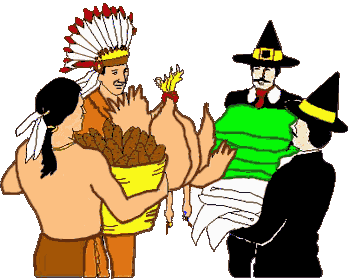The events of Plymouth in autumn 1621 relates to the first thanksgiving, there are 2 primary sources for them. However, research conducted by Center for World Thanksgiving at Thanks-Giving Square throws a good deal of light on the subject. Given below are the citations from the two original writings followed by an analysis of the roots of Thanksgiving. Enjoy the history of Thanksgiving and forward it to your friends.
"Our harvest being gotten in, our governor sent four men on fowling, that so we might after a special manner rejoice together after we had gathered the fruits of our labor. They four in one day killed as much fowl as, with a little help beside, served the company almost a week. At which time, amongst other recreations, we exercised our arms, many of the Indians coming amongst us, and among the rest their greatest king Massasoit, with some ninety men, whom for three days we entertained and feasted, and they went out and killed five deer, which we brought to the plantation and bestowed on our governor, and upon the captain and others. And although it be not always so plentiful as it was at this time with us, yet by the goodness of God, we are so far from want that we often wish you partakers of our plenty."
"They began now to gather in the small harvest they had, and to fit up their house and dwelling against winter, being all well recovered in health and strength and had all things in good plenty. For as some were thus employed in affairs abroad, others were exercised in fishing, about cod and bass and other fish, of which they took good store, of which every family had their portion. All the summer there was no want; and now began to come in store of fowl, as winter approached, of which this place did abound when they came first (but afterward decreased by degrees). And besides waterfowl there was great store of wild turkeys, of which they took many, besides venison, etc. Besides, they had about a peck of meal a week to a person, or now since harvest, Indian corn to that proportion. Which made many afterwards write so largely of their plenty here to their friends in England, which were not feigned by true reports."
The story of Thanksgiving is basically the story of the Pilgrims and their thankful community feast at Plymouth, Massachusetts.
The Pilgrims, who set sail from Plymouth, England on a ship called the Mayflower on September 6, 1620, were fortune hunters, bound for the resourceful 'New World'. The Mayflower was a small ship crowded with men, women and children, besides the sailors on board. Aboard were passengers comprising the 'separatists', who called themselves the "Saints", and others, whom the separatists called the "Strangers".
After land was sighted in November following 66 days of a lethal voyage, a meeting was held and an agreement of truce was worked out. It was called the Mayflower Compact. The agreement guaranteed equality among the members of the two groups. They merged together to be recognized as the "Pilgrims." They elected John Carver as their first governor.
Although Pilgrims had first sighted the land off Cape Cod, Massachusetts, they did not settle until they arrived at a place called Plymouth. It was Captain John Smith who named the place after the English port-city in 1614 and had already settled there for over five years. And it was there that the Pilgrims finally decided to settle. Plymouth offered an excellent harbor and plenty of resources. The local Indians were also non-hostile.

But their happiness was short-lived. Ill-equipped to face the winter on this estranged place they were ravaged thoroughly.
Somehow they were saved by a group of local Native Americans who befriended them and helped them with food. Soon the natives taught the settlers the technique to cultivate corns and grow native vegetables, and store them for hard days. By the next winter they had raised enough crops to keep them alive. The winter came and passed by without much harm. The settlers knew they had beaten the odds and it was time to celebrate.

They celebrated it with a grand community feast wherein the friendly native Americans were also invited. It was kind of a harvest feast, the Pilgrims used to have in England. The recipes entail "corn" (wheat, by the Pilgrims usage of the word), Indian corn, barley, pumpkins and peas, "fowl" (specially "waterfowl"), deer, fish. And yes, of course the yummy wild turkey.
However, the third year was real bad when the corns got damaged. Pilgrim Governor William Bradford ordered a day of fasting and prayer, and rain happened to follow soon. To celebrate - November 29th of that year was proclaimed a day of thanksgiving. This date is believed to be the real beginning of the present Thanksgiving Day.
Though the Thanksgiving Day is presently celebrated on the fourth Thursday of every November. This date was set by President Franklin D. Roosevelt in 1939 (approved by Congress in 1941). Earlier it was the last Thursday in November as was designated by the former President Abraham Lincoln. But sometimes the last Thursday would turn out to be the fifth Thursday of the month. This falls too close to the Christmas, leaving the businesses even less than a month's time to cope up with the two big festivals. Hence the change.
Try out the other sections